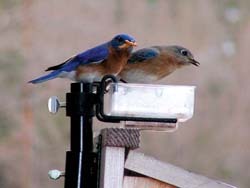
Mealworms Are for the Birds
Live Mealworms
Many birds eat insects naturally, so feeding mealworms to the birds is a natural thing to do. Plus, you’ll enjoy watching birds such as chickadees, bluebirds, wrens, towhees, woodpeckers, robins, catbirds, nuthatches, thrashers and others devour these mouthwatering morsels! A Nuthatch was seen taking mealworms from a feeder, and caching them at a rate of three per minute.
Mealworms are the larvae of the beetle Tenebrio molitor. The larvae stage of the beetle typically lasts for 10 weeks. To maintain the larvae in a state of dormancy, they must be refrigerated at 40 to 50 degrees Fahrenheit (lower temperatures can kill the larvae). You can keep mealworms for several weeks and they will maintain their dormant state.
You can place mealworms in a feeder or tray the birds regularly visit. Make sure the birds can access the feeder but that the worms can’t crawl out! Some Wild Birds Unlimited feeders to consider are the Dinner Bell and the SideDish™ feeders. Mealworms are a great way to attract birds that don’t ordinarily come to seed feeders.
Dried Mealworms
Here is some great information about why dried mealworms are a great source of food for wild birds, and that they're safe and a good way to help keep Birds diets diverse.
Follow this link to Dan Gleason's article at the WBU in Eugene Oregon to learn more about feeding dried mealworms.

